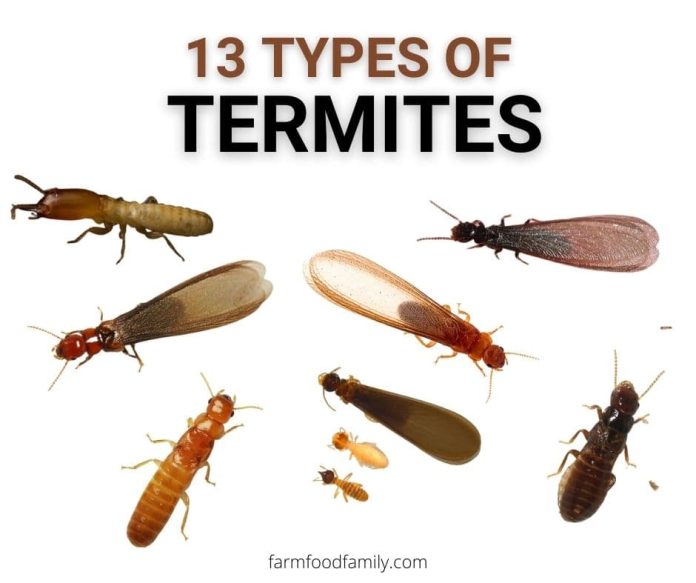13+ Different Types Of Termites With Pictures: Identification Guide
Known to be prolific wood eaters, termites are considered a nuisance in the home because they are silent destroyers. Sure, spotting one may not be a cause for concern, not knowing that they have already colonized your home, literally.
The tricky part here is that they do not all look the same and dismissing one not knowing that it is a type of termite could be dangerous.
In this post, we narrow down the types of termites and how they can be distinguished from one another. Basic characteristics and differences in features and behavior are also listed here. If you are interested in the types of termites for some reasons, read on.
Related: 5 Bugs That Look Like Termites But Aren’t
In this article:
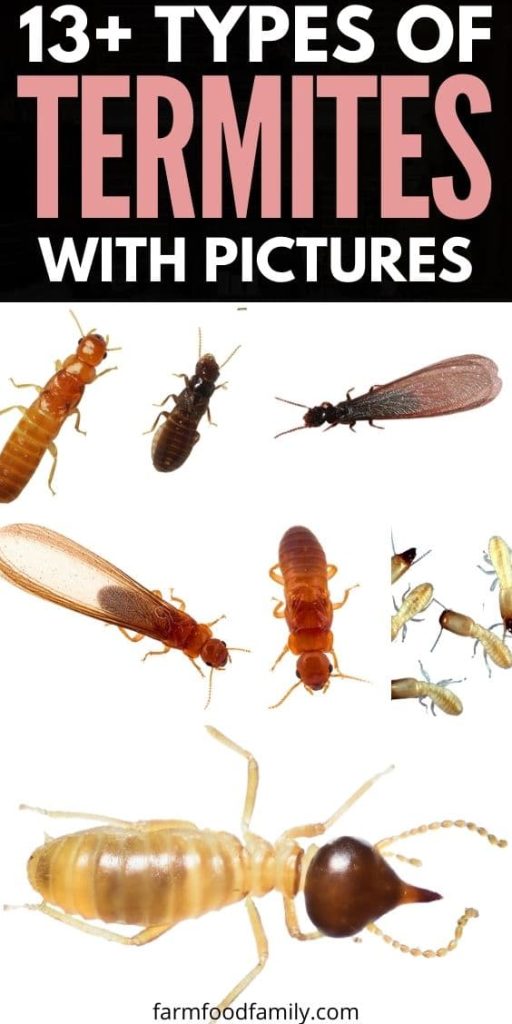
What is a termite?
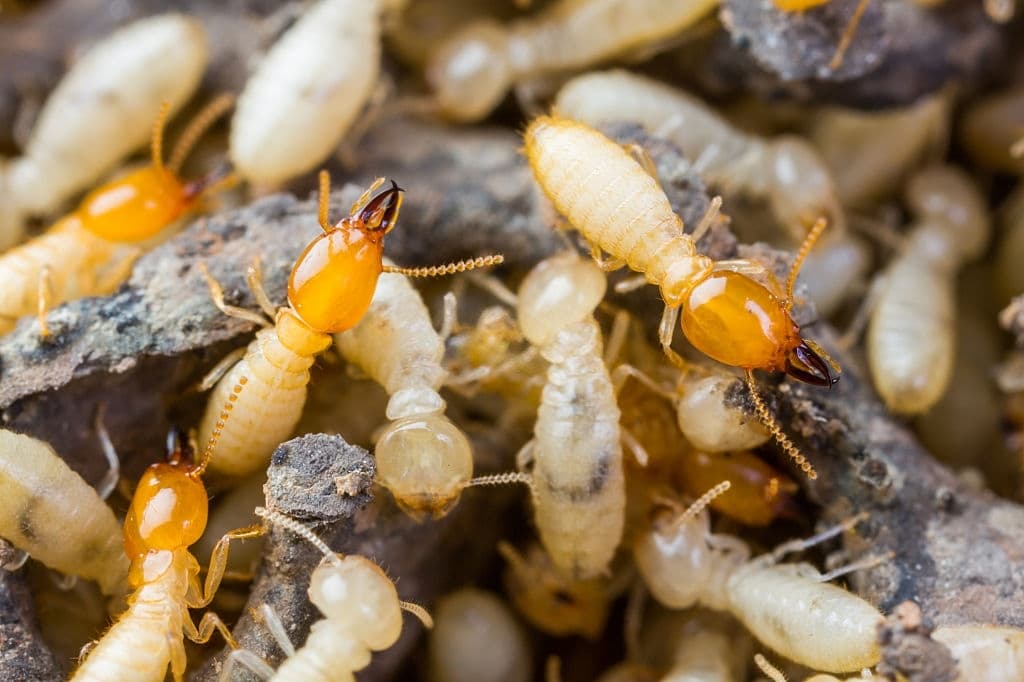
We already know them as one of the most prolific and destructive pests in the world. They are sometimes called as white ants because we are accustomed to their white, cream or almost translucent bodies (though these are their nymphs).
They are insects niching on leaf litters, wood, and soils. They have elongated bodies, follow a caste system, and are comparable to ants and other insects.
They build colonies both outdoors and indoors, in wood structures and underground. In the US alone, 50 species of termites are already found but the most common types would be the dampwood, subterranean, and drywood termites. Around the world, there are at least 2000 known termite species.
What do termites do?
While they look low-profile and unharmful, termites are pesky insects that wreak havoc to your home structure in the long run. There are four major reasons why termites should be eliminated immediately.
#1. Termites are damaging your home silently
We have already said that termites are silent destroyers. Unlike roaches and rodents, you would not usually see them at home. Termites on the other hand live in-wall, under the ground, and are silently eating away the wood structures in your home.
As such, the problem they pose might have become extensive before you could do something. For this, you have to be aware of identifying infestation marks.
#2. Hazard on wood structures
Although small in size, note that they are prolific egg layers and each colony is composed of thousands of termites. The wood structure in the home is indispensable and termite damage on these wood structures can become an infrastructure hazard.
You have heard of ceiling and walls collapsing because of termite damage. This alone proves why termites should be terminated immediately.
#3. They are hard to eliminate
Once they have established, they tend to be hard to control and eliminate. Termite professionals are called for in this situation because unlike other pests, they would find their way in your home again as long as there is wood to feed and niche on.
#4. Health hazards
You might not know it but termites, in their uber silent ways, can also pose health hazards to you and your family. For one, their presence could disturb mildew and molds in ceilings, flooring, and walls.
When they are shaken off, they can pose health hazards to those with allergies, asthma, sneezing, coughing, sore throat, itchy eyes and problems in respiration because of the presence of spores in the air.
Termite facts
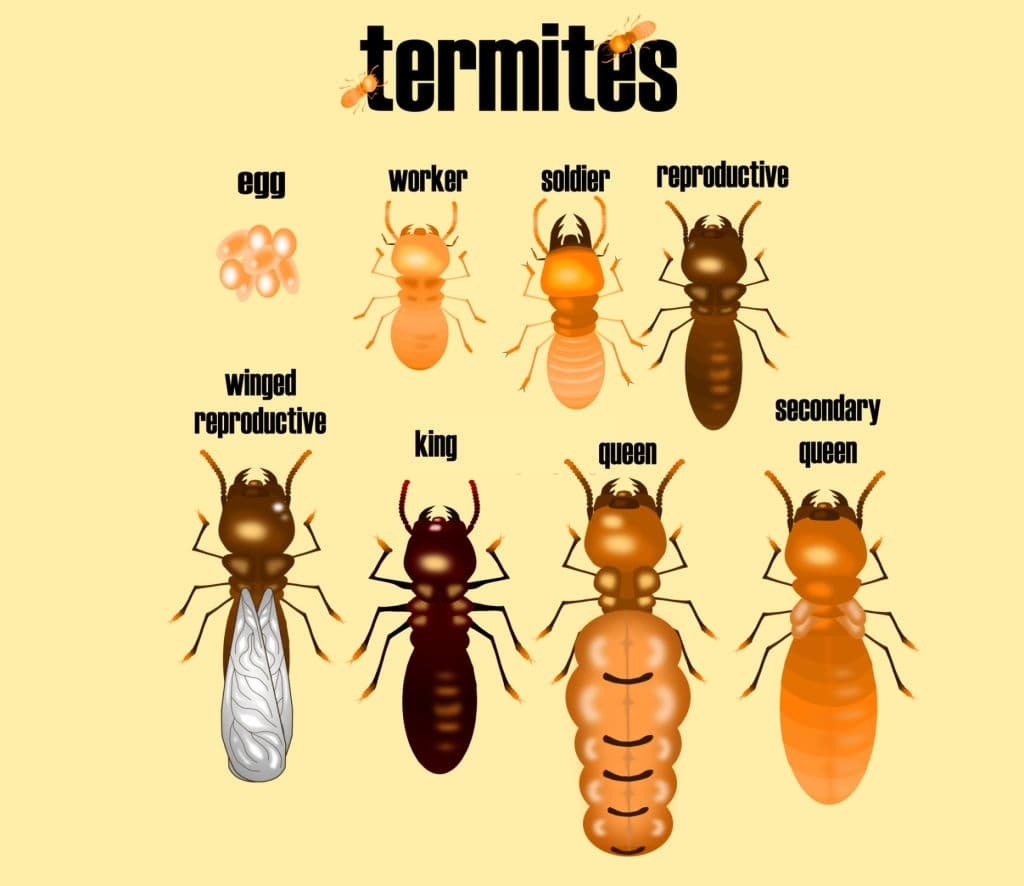
Before we rundown the types of termites and other information about these pesky insects that relate to hazards, termination, and more, let us first indulge in some termite facts that you might not know about.
- Termites never sleep. They build their colonies 24/7.
- The largest termite colony ever known contained three million termites.
- Termites are actually rich in protein, fatty acids, iron, and calcium so they are good to be eaten.
- Although always compared to each other, ants and termites actually hate each other. As a matter of fact, ants are the number one predators of termites.
- There are termite types that build their colonies upwards. In Africa, desert and drywood termites build upward mounts of at least 30-ft.
- Termites are dependent on their caste system. There is no termite type that does not have a caste system. This makes them eusocial insects.
- Worker termites do not only build colonies but they also feed the soldiers and the alates because these two cannot feed themselves.
- Termites are very hygienic. They always clean after each other.
- The role of termite queens is not just for reproduction. She also dictates the role of each termite in the caste system.
How to identify termites
It is hard to identify termites without comparing them to a more common insect. In this case, we shall compare them with ants so that you can have a more visual knowledge of how termites look like. Here is a five-point comparison between termites and ants to help you in identifying them at first glance.
| Termites | Ants | |
| Abdomen | Straight | Pinched |
| Antennae | Straight | Bent |
| Color | Depending on the caste, colors range from beige, cream, tan, black, and brown | Predominantly brown, black and red |
| Wings | Their wings are symmetrical and are longer than their bodies. | Winged ants have front wings that are symmetrical to their bodies and larger rear wings. |
Types Of Termites With Pictures
Believe it or not but there are different types of termites and not just the generic brown to black colored ones that you might have probably seen once at home.
In this section, we look at the various types of termites, where they niche, their unique behaviors, and other useful information that should help you in identifying which is which.
1. Conehead termites (Nasutitermes corniger)
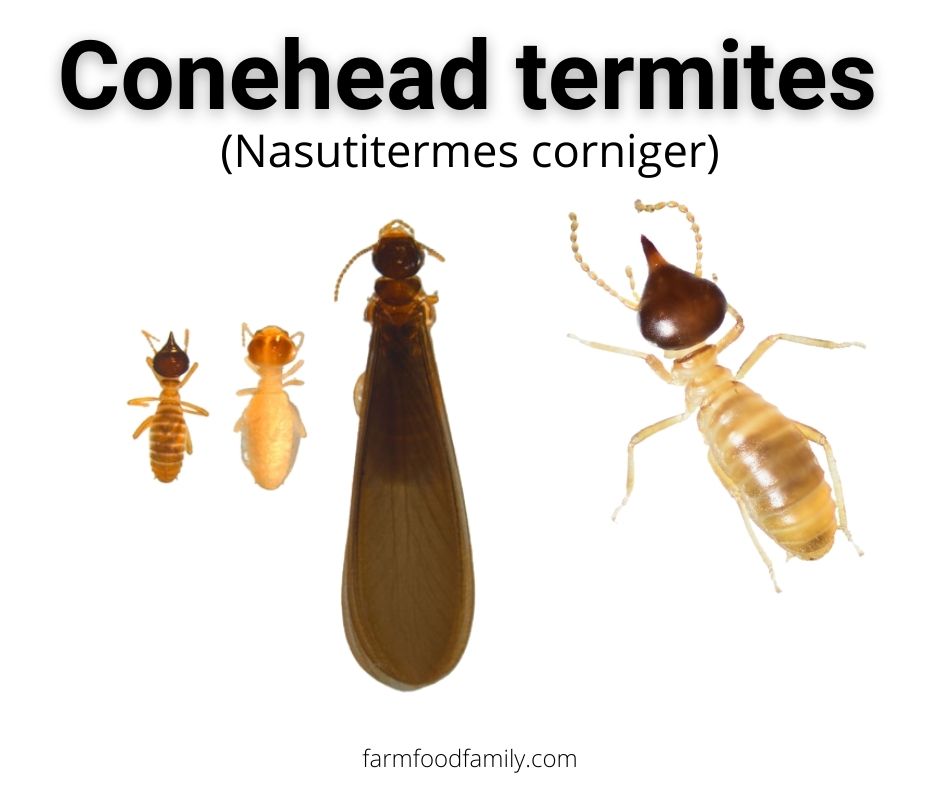
Previously known as tree termites, this termite group are said to have come from the Caribbean and found their way in the US woodlands just in 2003. They get their name well, from their orange cone shaped heads that become darker colored in age.
They are striking because they rummage food in an ant-like behavior, build larger niches than subterranean termites, and build open colonies above ground.
Composed predominantly of soldiers in their caste composition, it is understandable why they have the reputation of being very aggressive termites. Inside the home, they feed on anything that has cellulose. This includes shrubs, trees, paper, furniture, and wood structures.
2. Dampwood Termites (Zootermopsis angusticollis)
Their categorization already reveals that these termites love damp conditions. They usually live in wood piles as well as decaying wood and have a unique ability to thrive even without soil.
They usually feed on wood with lots of moisture content, hence, the name dampwood too.
2.1. Florida dampwood Termite (Neotermes castaneus)
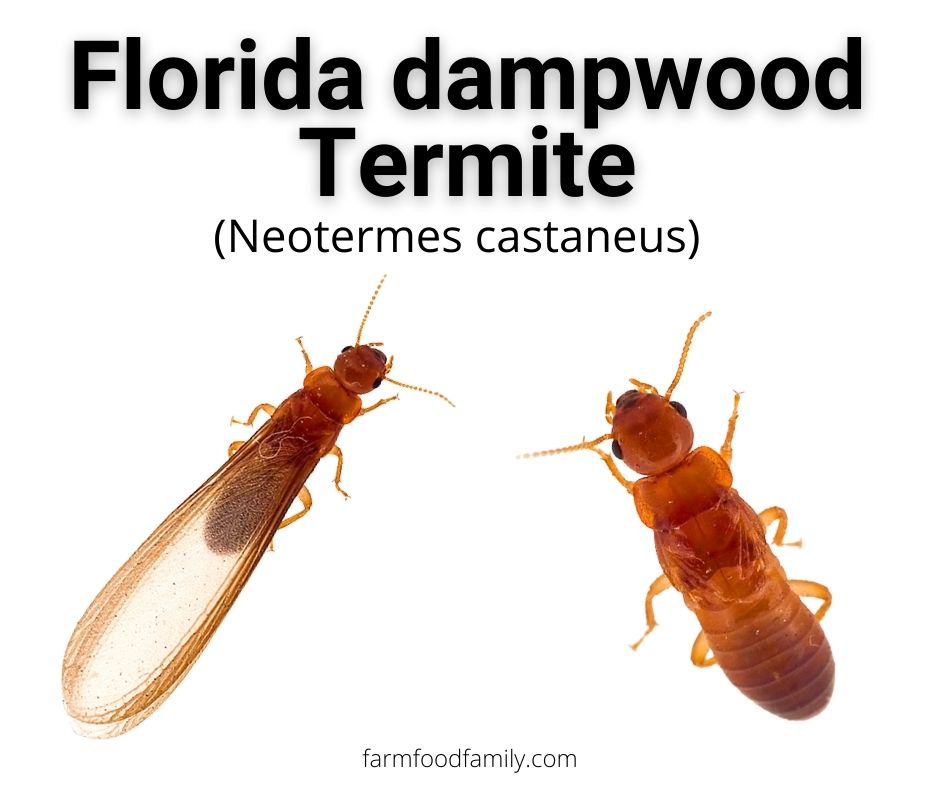
This one is considered as the largest termite group across the US, found across the Florida Keys. They niche on moist wood, and within high humidity conditions.
They do not build mud tunnels in the soil, instead, they build termite galleries within the woods they infest.
2.2. Desert Dampwood Termite (Paraneotermes simplicicornis)
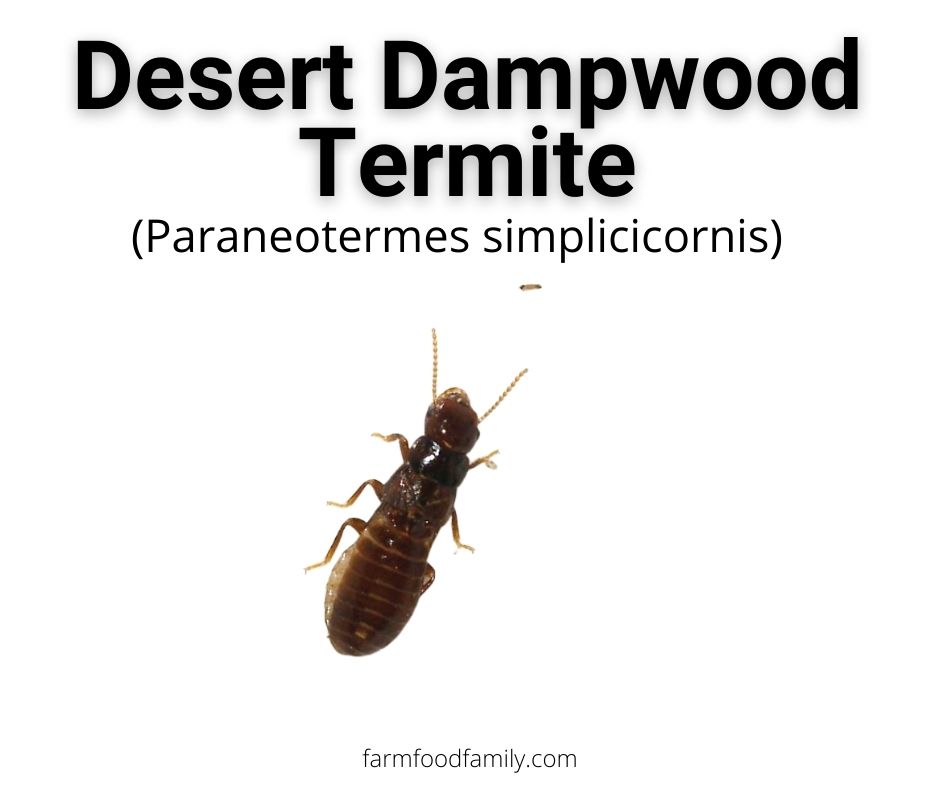
Physically, these dampwood termites are distinguishable for their spotted abdomens in colors of either brown, yellow, or both. They feed on damp wood and usually niche where wet wood structures are.
Desert dampwood termites are also unique for their infestation sign: the tunnels they make in the wood look like they have been smoothened by sandpaper.
2.3. Nevada dampwood/rottenwood termites (Zootermopsis nevadensis)

As the name suggests, this type of termite is endemic across Nevada as well as Idaho and Montana.
They have a caste system composed of the brown, large mouthed soldiers, cream-colored nymphs, and dark brown alates that grow to an inch in length.
They love to feed on structural wood and niche in soils that are prone to flooding.
3. Desert termites (Gnathamitermes tubiformans)
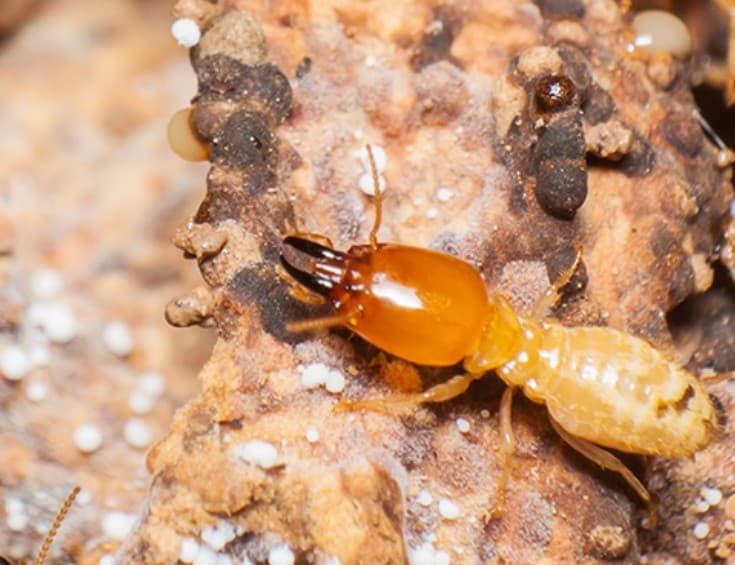
Not to be confused with some of the desert termites that we have discussed here, this group is found in the hotter regions of New Mexico, Texas, and Arizona.
Their caste system includes workers (taking up the most number in the colony), light brown, half-inch long, adult reproductive, and soldiers with a standout teeth-like mouthpart.
Desert termites are foragers, building mud tunnels in the soil. Their unique survival strategy would be the substance called carton. It is moisture retentive made from moist soil, organic matter, and their saliva. They feed on decomposing plant materials.
4. Drywood termites
By the name alone, you would already know that this termite type is found in the drier conditions of the Midwest and Southern states.
They can be a problem for the home because they are known to feed on wood flooring, wood structures, furniture and other wood frames.
4.1. Southeastern Drywood (Incisitermes snyderi)
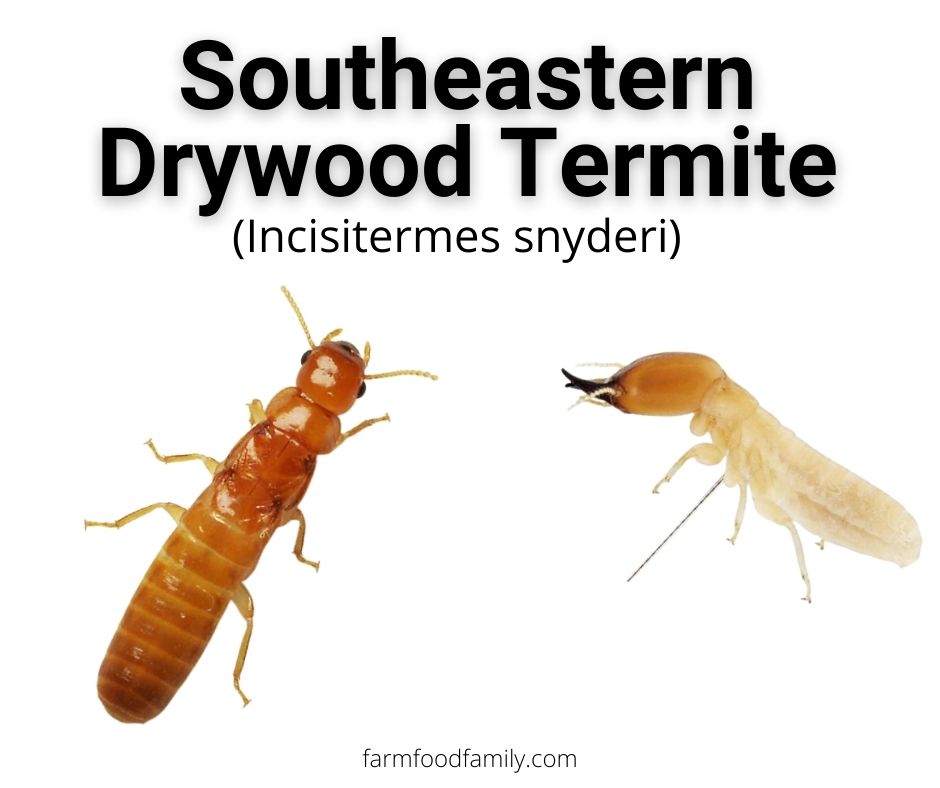
They look very similar with their drywood termite cousins but their distinguishing behavior would be the way they feed on wood.
Unlike all other drywood termites, they tend to eat the wood across the grain. They have small colonies (4000 per colony) and are found in Alabama, Texas, Florida and Georgia.
4.2. Western Drywood (Incisitermes minor)
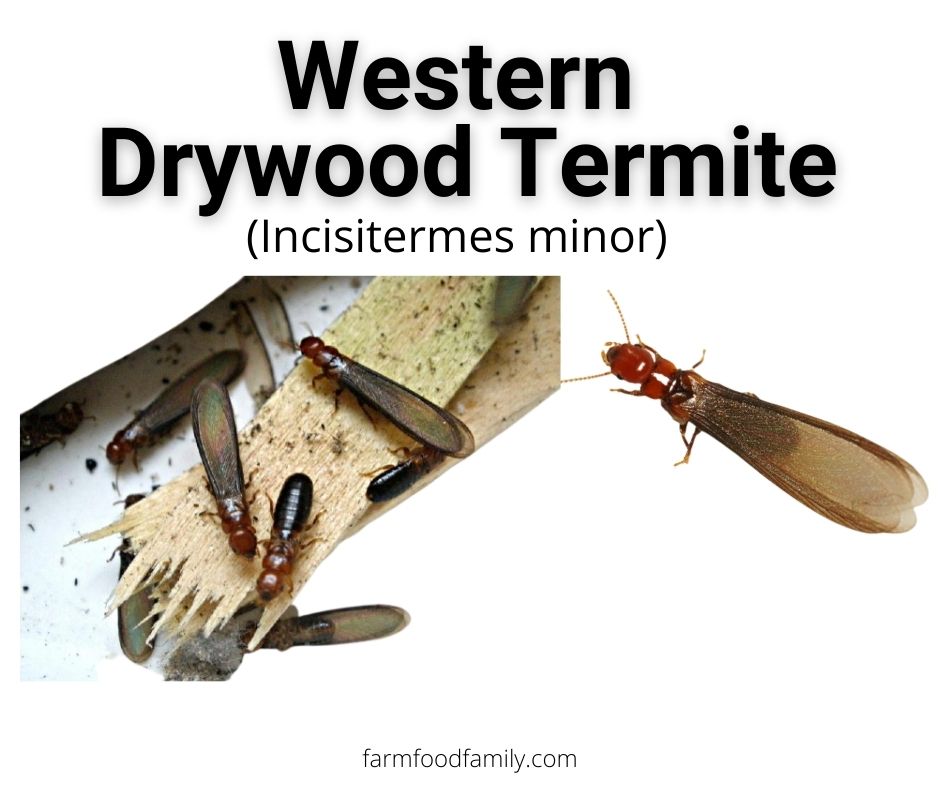
Compared to the southeastern drywood, this type builds smaller colonies (around 3000 per colony). They are found extensively in Arizona and California.
Their caste includes alates with a striking smokey-black color and soldiers with two mouthparts. They love feeding on exposed wood like those of window frames and furniture.
5. Formosan termites (Formosan subterranean termite)
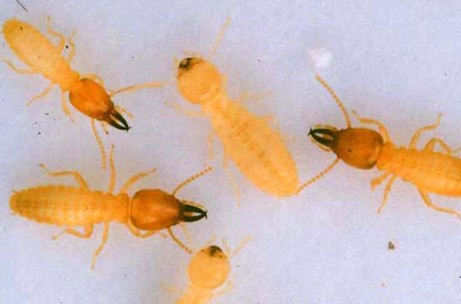
This group is also called the Asian termite because they are said to have originated from China. They thrive in coastal, tropical to subtropical regions in the US which includes Hawaii, California, Texas, Tennessee and Mississippi.
They are dubbed as the most destructive termite group because they are aggressive and voracious eaters.
They are strategists. They build their colonies in underground and walled structures. This group alone has at least 2000 known species. Their caste system includes very aggressive soldiers with an oblong head.
Their workers are the same as desert termites and their alates are yellowish brown and grow at a half-inch length. They are known to consume the largest amount of wood among all types of termites.
6. Subterranean termites
As the name suggests, this classification of termites live underground. They are outdoor termites that build vast colonies underground (said to contain more or less than 2-million termites if uncontrolled).
They love damp conditions and build mud tubes to travel from one place to the next or to access food.
6.1. Arid-Land Subterranean

This type of subterranean termites is extensively found from the West Coast to the Rocky Mountains. Its adult reproductives are distinguished for their clear wings, shiny black color.
The soldiers look like the adults but with a starkly long mandible while their workers are comparable to light colored ants. They niche in woodlands and their favorites are creosote and greasewood.
6.2. Dark Southeastern Subterranean Termite
This one is smaller than the termites of this type. They are only 1/3-inch in length and are known for their dark brown or black body. They are predominantly found in the East Coast.
Their soldiers are distinguishable for their rectangular mouths and heads. They particularly feed on structural lumber, pine wood and plywood. Their infestation trademark would be partially eaten wood.
6.3. Desert Subterranean Termite (Heterotermes aureus)
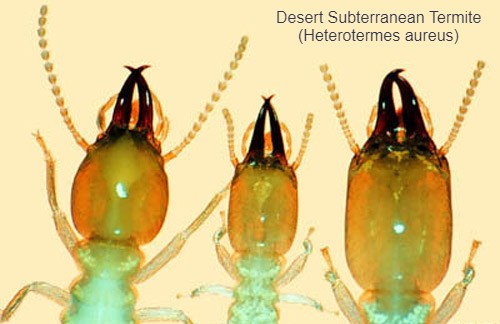
This type of subterranean termites is usually found in Southern California and Arizona. They are one of the smallest in the subterranean type, thriving in dry conditions.
The adults are yellowish brown in color while their soldiers are brown in color, sporting rectangular mandibles.
Their workers are cream colored and highly resembling ants in terms of appearance. They can attack wood structures, cacti, and some varieties of softwood. Look for a honeycomb print or a hollow section in woods containing mud. Those would be the alert signs for desert subterranean termite infestation.
6.4. Eastern Subterranean (Reticulitermes flavipes)
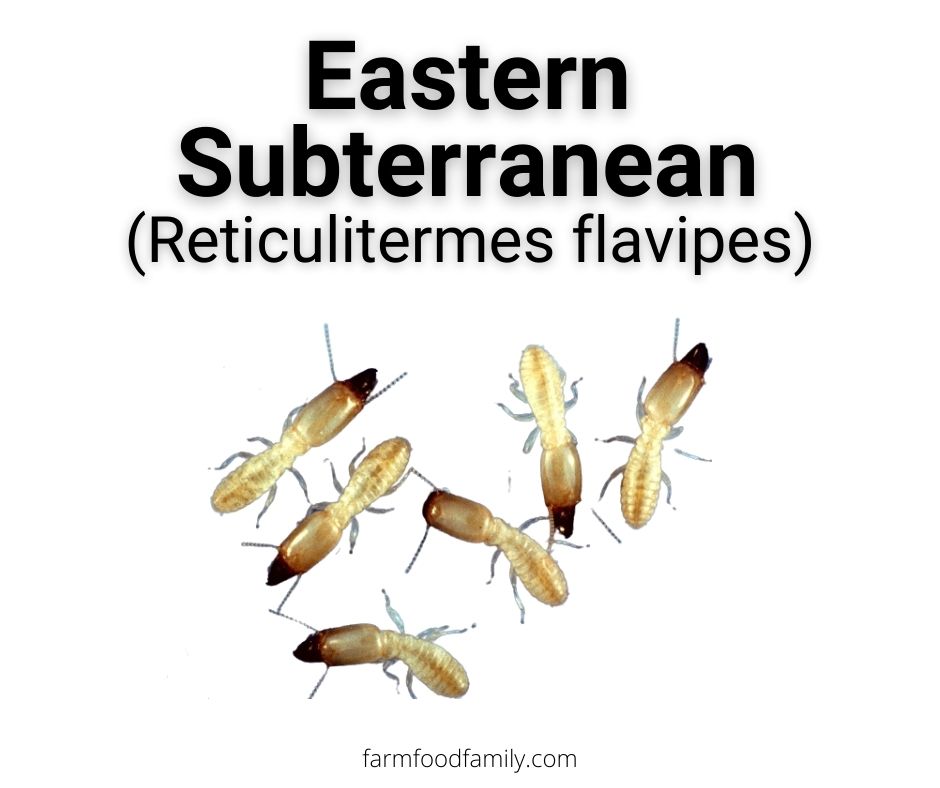
As the name suggests, they are found naturally in the East Coast up to the Midwest.
They are considered as the most functional and organized termite type, and as such, can be more destructive. They are cream in color, with elongated bodies, and at a half-inch length.
They are notorious for feeding on wood on building structures. The presence of mud tubes or wing shedding near doors, light sources, and doors confirm infestation of these termite types.
6.5. Western Subterranean (Reticulitermes hesperus)
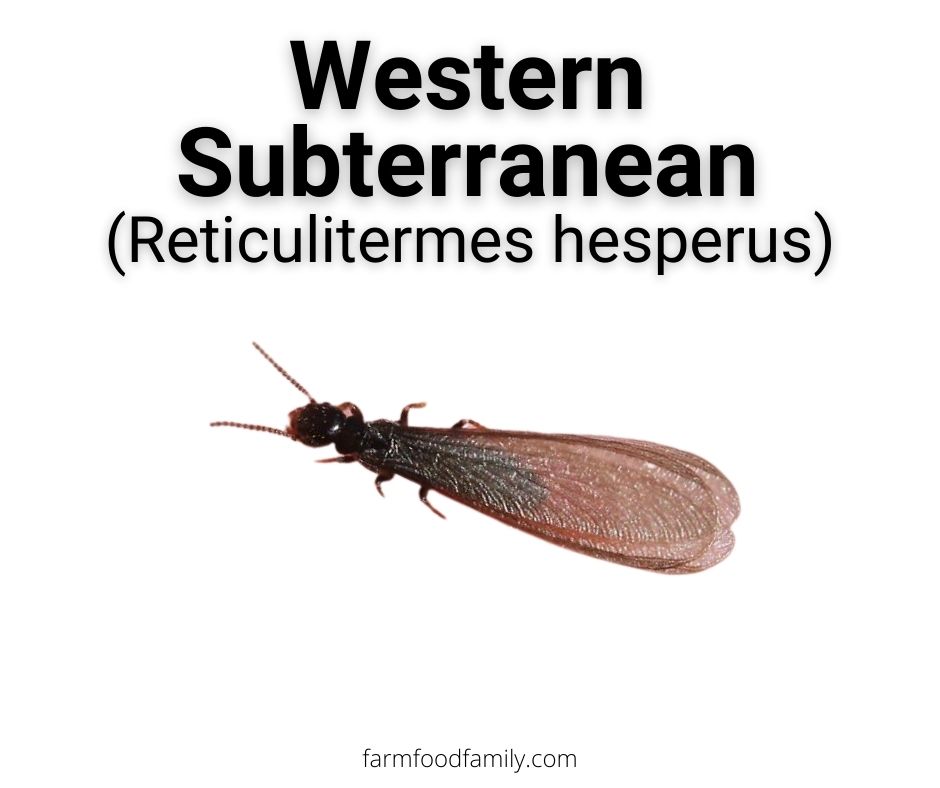
This one annually wreaks havoc in Washington, Nevada and California. They are especially notorious because they have a Queen producing at least 2000 eggs per day.
They also have cream-colored workers, soldiers with long pincers, and swarmers that are notable for their shiny, dark brown bodies.
They feed tree stumps, and decaying wood. Their eating behavior is quite unique as they employ trophallaxis which means that they exchange chewed food to distribute nutrients to each other.
FAQs
Aside from knowing the types of termites, there is also common termite information that you have to be aware of. As such, here are some termite FAQs that you should know of.
What are the worst termites?
As have been revealed here, the worst termites would be the Formosan termites. It is actually considered as a subterranean termite although they are larger than the known subterranean termite subtypes.
They live both underground and in-wall. They are dubbed as such because they consume the greatest amount of wood and they are also very aggressive. They are also the hardest to eliminate.
What do termites hate?
Like all other pests and pesky insects, termites hate strong scents. But according to research by Clemson University, termites specifically hate the smell of tea tree oil, cedarwood, and geranium. They also hate garlic, clove buds, and cinnamon.
What time of year do termites become active?
Termites are there year-round but different types of termites exhibit different levels of activity in different types of the year. For one, subterranean termites are most active during spring and summer.
Drywood termites on the other hand are most active during late summer up to fall while dampwood termites are active during spring.
Do termites fly?
Yes. The flying termites are technically called the swarmer or the alate. Their main role in the colony is to fly out to look for mates and ensure reproduction and to look for other nesting sites for new colonies. Alates are most visible during summer and spring. Seeing alate at home is a sure sign of infestation.
How do you tell if termites are active in your house?
Just because termites are silent destroyers would mean that you cannot know if there are termite activities in your home. Here are some of the most common signs that would tell that there are termites around your living space:
- Discolored walls
- Peeling paint walls resembling moisture damage
- Hollow sounding wood when tapped
- Small spots in drywood
- Buckling wood flooring
- Loosening tiles
- Squeaking floorboards
- Doors and window frames are stuck
- Damaged wood
- Maze like patterns along walls, furniture and flooring
- Termite pellets (they look like pepper)
- Wing piles resembling fish scales
- Mud tubes
- Swarming
- Clicking sounds in ceilings, flooring, and walls
How fast can termites destroy a house?
This one depends on the number of termites in a colony. But just think about it: the smallest colony is already composed of at least 2000 termites and it is not that long before they could pose significant damage to the home.
On average, termites can destroy a home 2-8-years. A more exact figure would be that they are able to eat a foot of wood in six months. Annually, termites damage at least 500,000 homes in the US alone.
Do termites live in trees?
Yes. Trees are where timber, logs and wood come from so understandably, termites can live directly in trees. Once you find mud tubes along tree barks, that is already an indication that termites live there.
And this should be a cause of concern because this means that the trees around your home are becoming unhealthy and it would just be a matter of time before they found their way inside your home.
Do termites bite people?
Termites do bite wood and furniture but fortunately, they never bite people. They may find their way on your bed, or be more visible during full-blown infestation, but rest assured that they would never bite you.
Are termites harmful to humans?
Yes. They might not bring viruses and bacteria but termites are harmful to humans because they activate spores coming from disturbed mildew and molds.
Having spores lingering in the air at home can cause asthma attacks and trigger allergies. They can also cause coughing, itchy and sore throat and eyes, sneezing, and other respiration-related issues.
Is a termite good or bad?
While termites are known to be more on the bad side, it does not mean that they do not have some good in them too. So, instead of answering this linearly, let us focus on why termites have good sides too.
For one, they support the ecosystem by being a stable food supply for birds, lizards, bugs, and anteaters, among others. Termites are also beneficial to the environment because they make soils more porous (for subterranean and desert termites) and also because they niche and feed on decaying leaves, trees, and other plant materials.
Can termites get in your bed?
Yes, but not all. The termite types that could find their way into your bed would be drywood termites and Formosan termites.
These two termite types love to eat wood structures like all else but they also predominantly love wood and door frames, floorboards, and furniture like chairs, sofas, and beds. As such, you can expect that in rare instances, termites can get in your bed.
Are termites hard to get rid of?
Very. Termites are hard to get rid of because there are just too many of them. Their colonies are composed of thousands of termites so you would expect that there would still be a considerable number of termites that would survive even after thorough extermination.
This is the reason why when you suspect termite activity or termite infestation, your best choice would be to call a termite exterminator professional immediately.
Why do termites swarm after applying treatment?
Swarming after applying treatment is common and this could occur for 4-6 weeks. The reason behind this is that treatments against termites specifically attack the workers and the adults which reproduce.
Eliminating the workers would and hampering their prolific reproduction ultimately weaken the colony, leading to total termination.
What attracts termites in the home?
The most common answer would be wood but depending on the type of termite that you have at home, some are also attracted to the dampness of the home, the steady moisture that they get and the humidity of the home.
Termites enter the home through leaky pipes, via branches and twigs from trees that fall near openings around the home, as well as small holes and crevices in the wall, ceilings and floors.
What wood will termites not eat?
You might not know this but termites also exhibit a level of pickiness when it comes to the type of wood they eat and it would be the following:
- Pressure treated wood: This one has embedded chemicals down to its pores making it resistant to fungi, rot, and well, termites. This is the reason why this type of structural wood is popular among basements, sheds, decks, and more.
- Naturally termite resistant woods: Believe it or not but there are natural termite repellent woods. On top of the list would be the heartwood. Its density makes it impermeable to termites so they naturally resist the tree. Other naturally termite resistant woods would be yellow cedar, cypress, Laotian teak, and redwood.
- Composite materials: This one emerged as a popular structural material because they are specifically designed to deter them. Aside from being durable and affordable, termites hate them because they cannot eat plastic (of which composite materials are made of).
What is the most common termite type in the US?
The subterranean termite is considered as the most common termite in the US. They are believed to be thriving in all American states with the exception of Alaska. They are most extensive around subtropical locations ranging from Southern California to Florida.
Are termite damages covered by home insurance?
Unfortunately, no. Because they are a common occurrence in homes since most still use them for their frame and structure, homes are truly vulnerable to termites.
Reports note that termites pose an accumulated property damage cost at $5M every year. As such, it is understandable as to why termite damages are usually not covered by home insurance.
Are there tools or gadgets that can detect termites?
Interestingly, yes. There are termite detectors that you can buy to confirm if there is termite activity in the walls, ceilings, and floors.
These detectors are made of thermal and moisture sensors, tracking the movement and estimated size of the colony in your home. While their effectiveness is still in question, it would be good to have one for you to know if it is time to call for a pest control professional.
Related:
Conclusion
Termites are very common pests and when you see one or suspect that your home shelters a colony, they should always be a cause of concern.
They are prolific layers, silently niching in your home’s structures and feeding on your wood structures. They can pose a serious threat to your home’s foundation and they could also induce health hazards especially allergy triggers and asthma attacks.
With everything we have covered here, the best solution to approach termites would be to exterminate them once and for all. While this is not a one-time-big-time thing, calling a reputable termite control professional would be the best course of action to stop termites from invading your home.

